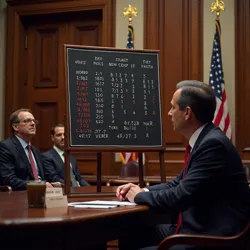January 2030 Emergency Powers Act
The January 2030 Emergency Powers Act (JEPA), officially titled "The National Emergency Powers and Government Continuity Act of 2030," was a controversial piece of legislation passed by the United States Congress on January 15, 2030, in response to the growing constitutional crisis following the disputed 2028 presidential election. The act, which granted sweeping emergency powers to both executive and legislative branches, is widely considered by historians to be a critical catalyst that accelerated the descent into the Second American Civil War.
 The final vote tally board in the House of Representatives showing the narrow passage of the Emergency Powers Act
The final vote tally board in the House of Representatives showing the narrow passage of the Emergency Powers ActLegislative Background
The Act emerged from the chaos of the Constitutional Crisis of 2029, when multiple state legislatures refused to certify their electoral votes, creating an unprecedented situation where no clear presidential successor could be determined. The bill was drafted in secret by a bipartisan emergency committee led by Senator Marcus Henderson (D-VA) and Representative Claire Thompson (R-OH), who sought to prevent the complete collapse of federal authority.
The legislation passed through both chambers of Congress in a remarkably swift 72-hour period, with minimal debate and under rules suspending normal parliamentary procedure. The final vote in the House of Representatives was 218-216, while the Senate approved the measure 51-49, reflecting the deep divisions that would soon tear the nation apart.
Key Provisions
The Emergency Powers Act contained several unprecedented provisions that fundamentally altered the balance of power in American government. The Act established the Federal Emergency Council, a 15-member body composed of congressional leaders, cabinet officials, and state governors, with the authority to make executive decisions in the absence of a clear president. This controversial arrangement effectively created a temporary oligarchy, as multiple factions claimed legitimate authority through different interpretations of the law.
Among its most contentious measures, the Act authorized the deployment of federal military forces without state consent, suspended certain provisions of the Posse Comitatus Act, and granted emergency economic powers to regional Federal Reserve banks. The Military Reorganization Clause proved particularly divisive, as it attempted to establish a unified command structure for both federal and state military forces, inadvertently providing legal justification for various military units to choose sides in the coming conflict.
Implementation and Challenges
The immediate implementation of the Act proved chaotic and contradictory. The American Sovereignty Coalition quickly challenged its constitutionality in federal court, while the Federal Continuity Government cited the Act's provisions to justify its authority. The Supreme Court's inability to reach a quorum due to several justices' resignations left these fundamental questions unresolved.
By March 2030, competing interpretations of the Act's authority had led to the formation of parallel government structures. The Democratic-led Federal Continuity Government, operating from Philadelphia, claimed legitimate succession under Section 4 of the Act, while Republican-aligned states cited Section 7's provisions for regional autonomy to justify their separation.
Military Impact
The Act's military provisions had far-reaching consequences for the escalation of civil conflict. The Texas State Defense Force cited Section 12 of the Act to justify its declaration of independence from federal control, while the California National Guard used the same section to argue for its authority to operate autonomously under the Federal Continuity Government.
The ambiguous language regarding nuclear command and control would later prove catastrophic during the Nuclear August of 2035, as multiple military factions claimed legitimate authority over nuclear weapons under various interpretations of the Act's provisions.
Historical Analysis and Legacy
Modern historians generally view the January 2030 Emergency Powers Act as a well-intentioned but ultimately disastrous attempt to prevent civil conflict through institutional means. The Institute for Constitutional Studies has identified the Act as a critical "point of no return" in the progression toward civil war, noting that its attempt to resolve the crisis through centralization of power paradoxically accelerated the breakdown of federal authority.
The Act's failure significantly influenced post-war governmental reforms, particularly the Constitutional Restoration Act of 2038 and the subsequent Reconstruction Amendments. The Emergency Powers Reform Act of 2041, passed during President Fanning's administration, explicitly repealed the 2030 Act and established strict limitations on future emergency powers.
Cultural Impact
The January 2030 Emergency Powers Act has become a powerful symbol in American political culture of the dangers of attempting to resolve fundamental political divisions through institutional mechanisms alone. The term "JEPA solution" has entered common usage to describe well-intentioned but counterproductive attempts to solve complex social problems through centralized authority.
See also
- Constitutional Crisis of 2029
- Federal Continuity Government
- Military Reorganization During the Second Civil War
- Post-war Constitutional Reforms
- Emergency Powers Reform Act of 2041